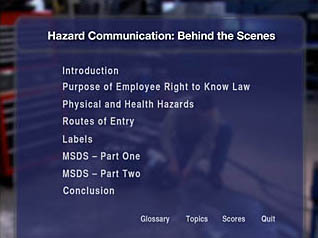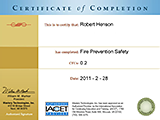HazCom: Hazard Communication: Behind the Scenes
- Product ID
- aurohcbs
- Training Time ?
- 42 to 84 minutes
- Language(s)
- English
- Video Format
- Standard Definition
- Required Plugins
- MasteryNet Player
- Lesson Interactions
- 9
- Quiz Questions
- 29
- Closed Captioning



Online Hazard Communications Training
This course covers all aspects of working with hazardous materials. This hazard communications course features high-quality, interactive video. It also addresses the roles and responsibilities from an employee and employer perspective. It discusses physical and health hazards, chemical routes of entry into the body, and information found on labels and MSDSs.
CERTIFICATE/ACCREDITATION
You will earn a certificate upon completion. This course qualifies for continuing education units.
YOU CAN HOST THIS COURSE ON YOUR SITE
You can take this course from our site or install it on your own corporate online training site.
OSHA REGULATION: OSHA 29 CFR 1910.1200.
![]() This course is in the Advantage™ format, to read about Advantage™ features click here.
This course is in the Advantage™ format, to read about Advantage™ features click here.
- Install on any SCORM LMS
- Rich multimedia presentation with interactions and quiz
- Print certificate and wallet card
- You have 30 days to complete the course
- CEUs awarded
For all workers.
-
Hazard Communication Standard
- Employer responsibilities
-
Physical and Health Hazards
- Physical hazards
- Chemicals that produce physical hazards
- Health hazards
- Acute health effects
- Chronic health effects
-
Routes of Entry
- Routes of entry explained
- Routes of entry examples
- Protection from airborne chemicals
- Protection from chemical absorption
- Avoiding contamination of food with your hands
-
Container Labels
- Finding labels
- Applying labels
- Information on container labels
- Flammable, combustible, and corrosive chemicals
- Transferring a chemical to another container
- Maintaining labels
-
Material Safety Data Sheets
- Product and company identification
- Exposure limits
- Emergency response
- Firefighting and flash point
- Handling, storage, PPE and exhaust ventilation
- Physical and chemical properties
- Specific gravity
- Stability, reactivity, and poisonous effects
-
Household Chemicals
- Precautions with household chemicals
-
Explain the Right to Know Law employer requirements
- Recall the need to prepare a written plan.
- Explain the need to inventory hazardous chemicals.
- Recognize the need to maintain a Material Safety Data Sheet file.
- Identify the safety benefits of container labels.
- State the requirement to train employees about chemical safety procedures.
-
Protect yourself from the physical and health hazards of chemicals.
- Differentiate between physical and health hazards.
- Identify examples of physical hazards.
- List types of chemicals that produce physical hazards.
- Explain that chemicals can affect body systems as well as specific organs.
- Distinguish the difference between chronic and acute health effects.
-
Avoid chemicals entering your body.
- Define routes of entry.
- List a chemical's available routes of entry into the body.
- Choose the proper protection to avoid exposure from airborne chemica
- Select the proper procedure to avoid exposure from absorbtion through the skin and eyes.
- Identify the proper procedure used to avoid ingesting hazardous chemicals.
-
Read labels to locate necessary safety information.
- Agree that all containers of hazardous chemicals must be labeled.
- Name the person(s) responsible for labeling containers.
- List information found on container labels.
- Identify the labeling requirements when transferring a hazardous from one container to another.
- Recognize the importance of label maintenance and legibility.
-
Use Material Safety Data Sheets to get specific information.
- List information contained in an MSDS.
- Define Permissible Exposure Limit and Threshold Limit Value.
- Identify the types of emergency information included in an MSDS.
- Define Flash Point.
-
Use Material Safety Data Sheets to get specific information.
- Define Vapor Density.
- Define Specific Gravity.
- Identify various information found on an MSDS.
© Mastery Technologies, Inc.



